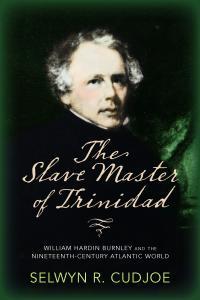Dreaming of a Black Christmas
By Dr Selwyn R. Cudjoe
December 26, 2023
There was a large picture of Jesus at the entrance of our home when I grew up in Tacarigua. In this picture, Jesus' skin was white, his hair was blonde, and his eyes were a piercing blue. This represented the saviour who is supposed to save us from our sins and prepare us to enter into the heavenly kingdom. This depiction of Jesus was a Western whitewashing of history.
Jesus was born in Bethlehem during the first century of the Christian era. He was raised in Nazareth, formerly known as Palestine which is now part of the Israel-occupied territory of the West Bank. Artistic representations in the first three centuries depicted Jesus as "the Good Shepherd, a young, short-haired, beardless man with a lamb around his shoulder". (Sarah Pruitt, "What Did Jesus Look Like?"). Joan Taylor, a Christian Origins scholar, tells us that "like most people in Judea and Egypt around the time, Jesus most likely had brown eyes, dark brown to black hair and olive-brown skin".
Three thousand years before the emergence of Christianity, Egyptians proclaimed the doctrine of eternal life and the resurrection of a spiritual body. The prayers, hymns and short litanies inscribed upon the walls of tombs of the Egyptian kings referred to the presence of life after death. EA Wallis Budge notes: "The chief features of the Egyptian religion remained unchanged from the Vth and VIth dynasties down to the period when the Egyptians embraced Christianity, after the preaching of St Mark, the Apostle in Alexandria, AD 69, so firmly had the early beliefs taken possession of the Egyptian mind." (The Egyptian Book of the Dead.)
Jesus' birth introduced Christianity into the world. His disciples spread his teachings (the gospels) in the first century. But it was in the northern cities of Africa, in the second, third and fourth centuries that Christianity developed. Jesse Page observes: "[These cities] were sanctuaries of learning. Amid the darkness [of that continent] shone the lamps of Divine truth, where Christianity, still young, inspired its confessors and saints... We often fail to realise that these great councils of the early centuries were crowded with African bishops, representing hundreds of native churches." (The Black Bishop.)
Some of the black fathers of the church were Tertullian (155-220), the "father of Latin Christianity" and the founder of Western theology; Cyprian (200-258), an early Christian theologian and bishop of Carthage (present-day Tunisia); Origen of Alexandria (185-253), an early Christian scholar; Athanasius of Alexandria (296-373), one of the great Church fathers and an Egyptian Christian leader of the fourth century; and St Augustine of Hippo (354-430), the most significant Christian thinker after St Paul.
Both Christianity and Islam (which began in 610 CE) were adapted from African religions to fill the needs of their time. Ideas such as the One, Eternal God, the creation of the world, the future life, and three people in one God are taken from Egyptian religion. Otto Meinardus notes: "The ankh, originally the pharaonic symbol of life, was not employed in a specifically Christian context, that is, representing salvation through the various deaths of Christ, before the fifth or sixth century, or one or two centuries after the Christianisation of the Nile Valley." (Two Thousand Years of Coptic Religion.)
Elements of Egyptian religion can be seen in early Christianity. Paul elaborated on the theology of the Cross when he introduced the concept of a Redeemer "who gave himself for our sins, that he might deliver us from this present evil world" (Galatians, Ch 4). However, he was speaking not of the Roman cross of punishment but of the Egyptian ankh (cross), a symbol of Christ's victory over death that early Christians adopted during the first three centuries of their existence.
Thales, Pythagoras, and Socrates studied in Egypt and the Holy Family found refuge from King Herod's wrath there. When I visited Egypt in 2000, much of the Bible was palpably present. Moses, the most important prophet in Judaism, Christianity and Islam, and Akhenaten, the pharaoh, who first recognised the existence of One, Eternal God, were Egyptians.
There were also Trinidadian preachers who recognised the importance of Egypt in constructing Christian doctrine. Joshua Stanley, a lay preacher at St Mary's Anglican Church, Tacarigua (1920 to 1965), preached on the Egyptians, their conception of life after death, and monotheism.
In October 1923 he expounded on the Egyptians' notion of the afterlife: "If you believe the Bible, there is certainly a hereafter. If we look at actions of the Egyptian kings in the very early times, we see them in their lifetime, they provided in their own ways, to the best of their abilities, means of traveling from this world to the Great Beyond. They spent all their wealth to provide beautiful and lasting and magnificent tombs and the best materials to preserve their body so that it may pass into the other world preserved."
Stanley was no ordinary lay preacher. He was an intellectual who was steeped in Africans' contribution to theology. He drew on St Augustine's notion of God's perfection and explored the roots of Latin and Greek words to demonstrate his points. I admired Stanley enormously. He taught us about Africans' contributions to the making of Christianity.
During the Christmas season it would be nice if we can ponder Africa's contribution to Christianity.
—Prof Cudjoe's e-mail address is scudjoe@wellesley.edu. He can be reached @ProfessorCudjoe.
Share your views here...

The Slave Master of Trinidad by Dr. Selwyn R. Cudjoe
|

